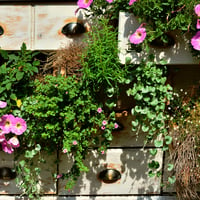10 Best Balcony Plants for Sunny Balconies
Written by GardenOrnaments.com on 27th Jan 2020.
Describing 10 best balcony plants for sunny balconies is like describing the ten best trees for your back garden.
The first question that needs to be asked is “What kind of balcony, where?” Some balconies are sunny all year around while some are only sunny part of the year. Others might be sunny all year round, but only warm part of the year.

The amount of rainfall in your area, the ambient temperature, the general humidity and the number of sunlight hours per day will affect your choice of “best balcony plant.”
Flowers – Suitable for many climates, here is one annual and one perennial house plant.


- Marigolds. Super easy annuals that come in a variety of colors and sizes. They range from 4 inches to 4 feet tall, with proportional width. Colors range from a bold yellow to deep red, with shades all in between. They are excellent as companion plants because they repel a variety of insects.
- Geraniums. Another easy-to-grow flower, but traditionally kept as potted plants. If you coddle them, they will continue to grow and perhaps even bloom through the winter. You can encourage blooms by deadheading (removing the spent blooms). More delicate in color than marigolds, they are still a delightful beginner plant. Perfect for planting in all sorts of plant pots, garden ornaments or garden troughs.
Cactus – Cacti are great for regions where that south-facing balcony becomes super warm in summer.

- Golden barrel. Originally from an arid part of Mexico, these round cacti store water in their ridges. They produce colorful blooms as a sort of top-knot at the apex of the “barrel.” Be sure to purchase from a reputable grower, as they are endangered in their native habitat.
- Christmas cactus. Beautiful plants that produce vine-like flat segments that are connected with joints. As the name implies, they tend to bloom in December when kept in a warm, moist environment. They make a beautiful showing trained under a skylight in winter, but also create a lovely bit of green on your balcony in summer.
Succulent – A plant that has fleshy or juicy tissues. Cactus are sometimes defined as succulents, but there are other plants that fit the description.
- Hens and chicks. Members of the sempervivum family, these succulents form adorable rosettes that quickly create babies. They are a favorite for placing in strawberry jars because they are hardy and can take quite a bit of neglect.
Herbs – Woody or stemmy plants that are used for cooking, medicine or to produce delightful fragrances.



- Yarrow. Grows like a weed because in some places it is a weed. It can have white, yellow or purple flowers. For your balcony, they can be massed as a tall background for shorter plants. Their dusty gray leaves have a lacy or fernlike appearance.
- Purple Basil. Basil is in every way delightful. It has been used medicinally, but it is more popular as a seasoning for tomato or cheese dishes. Brush against this plant and the area will be filled with a heavenly aroma. Can grow from 2 to 4 feet tall.
- Thyme. An excellent grown cover or foreground plant. The tough little plants look very much like tiny trees. Add a pinch to your food for a flavor explosion.
Vines – Twined over railings or up trellises, vines can help shade your balcony so that you can enjoy a cool spot with perhaps a bit of breeze.

- Cardinal Climbers. Annual vines with wide, lacey leaves studded with hundreds of tiny red flowers. Their throats are too narrow for most bees, but hummingbirds love them. Twine them around a hummingbird feeder to attract a good share of these jewel-like little birds.
- Moonflower. Wide, white flowers that have a delicate appearance open in the evening as the sun is setting. These heirloom flowers have a lovely vine that can help with creating shade for your balcony.
Ornamental Vegetable
- Scarlet Runner Bean. This versatile bean vine has tiny red blossoms and lovely wide green leaves. Although not as prolific as regular vegetable garden beans, it does produce edible bean pods.
Conclusion
For best results, select some tall plants, a vine or two, some medium-sized plants, and some short ones. Consider your climate and the effect you wish to create on your beautiful balcony.